93 - Solitary Pulmonary Nodule
Editors: Shields, Thomas W.; LoCicero, Joseph; Ponn, Ronald B.; Rusch, Valerie W.
Title: General Thoracic Surgery, 6th Edition
Copyright 2005 Lippincott Williams & Wilkins
> Table of Contents > Volume II > Section XVI - Carcinoma of the Lung > Chapter 108 - Endoluminal Management of Malignant Airway Disease
Chapter 108
Endoluminal Management of Malignant Airway Disease
Joseph LoCicero III
Because patients with endobronchial tumor obstruction often present with acute and dramatic symptoms, they have been the subject of considerable investigation during the last quarter century. Many physicians and surgeons developed innovative methods to relieve the acute symptoms. Now, most patients present with symptoms of obstruction after some initial therapy for lung cancer. Yet approximately 7% of all newly diagnosed lung cancers still present with primary obstruction.
Despite presentation with dyspnea, hemoptysis, or obstructive pneumonia, most patients can be managed conservatively. Hospitalization and initiation of oxygen therapy, sedation, and antibiotics often ameliorate the acute symptoms, allowing completion of medical evaluation and staging of the tumor. Approximately 20% of patients with newly discovered lung cancer still have early-stage disease and will be candidates for surgical resection. In such patients, pulmonary function testing, nuclear perfusion scanning, and accurate surgical mediastinal exploration may be necessary. The best form of treatment for most of the late-stage or medically inoperable patients having no previous therapy is palliative external beam radiation therapy. Endobronchial management thus becomes a secondary palliative method for those patients who remain acutely ill with initial unabated symptoms or those who fail following, or progress during, palliative radiation therapy.
METHODS OF EVALUATION
Several investigators have attempted to objectify pretreatment and posttreatment signs and symptoms (Table 108-1). Quantitative signs and symptoms include segmental, lobar, or lung collapse evident on radiography of the chest, changes in spirometry or flow-volume loop on pulmonary function testing, and changes in oxygenation status. Bronchoscopic documentation of percentage of obstruction is the most objective value and is the easiest to estimate. Semiquantitative signs and symptoms include shortness of breath, hemoptysis, and fever. Subjective criteria include nebulous symptoms such as fatigue, cough, wheezing, or stridor.
Table 108-1. Measures of Obstruction | |
|---|---|
|
According to Schray and colleagues (1988), 68% of patients present with dyspnea, 37% with hemoptysis, 28% with cough without hemoptysis, and 14% with no subjective symptoms. Walsh and associates (1990) attempted to quantify the symptoms for better pretherapy and posttherapy comparisons. They used a dyspnea scale, evaluation of segmental collapse on chest radiography, pulmonary function testing, including forced expiratory volume in 1 second, the ratio of this value to forced vital capacity, midexpiratory flow rate, and arterial oxygenation. They added a 6-minute walk test performed on level ground to assess the endurance of the patients and their potential for oxygen desaturation.
I and my colleagues (1990) have confirmed that despite careful evaluation, functional tests correlate poorly with symptomatic improvement. Most patients achieve symptomatic improvement with little change in objective numbers, with the exception of the chest radiography. Radiographic evaluation of improvement in collapse also gives an excellent and easily evaluable criterion (Fig. 108-1). Peripheral saturation and the radiographic picture together are excellent predictors of the potential effectiveness of the therapy because oxygen desaturation is a reflection of ventilation-perfusion mismatch due to segmental collapse. Cough and hemoptysis are present in many patients and are often relieved by noninvasive therapy. Improvement in the 6-minute walk test is usually but not always accompanied by symptomatic relief.
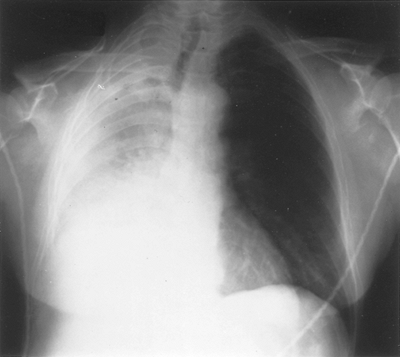 |
Fig. 108-1. Chest radiograph of a patient with near total obstruction of the right main-stem bronchus. This patient presented with severe shortness of breath. Predictably, early reestablishment of a patent airway ameliorated all symptoms. |
Another attempt at objective evaluation is the simple dyspnea scale (Table 108-2). This takes the rather subjective symptom of shortness of breath and makes it quantifiable. Some investigators add general functional evaluation,
P.1605
such as the physical status scale (0 to 4) or Karnofsky's scale (0 to 100), to their pretherapy evaluation.
Table 108-2. Dyspnea Scale | ||||||||||||
|---|---|---|---|---|---|---|---|---|---|---|---|---|
|
MANAGEMENT STRATEGIES
Table 108-3 lists the wide variety of techniques available to manage tumor obstruction of the trachea and bronchi. Each has advantages and disadvantages. Sometimes, a combination of techniques may be used to minimize the disadvantages of any one therapy.
Table 108-3. Endoluminal Tumor Management | |
|---|---|
|
Mechanical D bridement
The earliest method of endobronchial tumor management was simple mechanical removal. Jackson and Kozelman (1943) reported reasonable success with this technique. Later, in 1959, Jackson reported establishment of a patent airway simply by mechanical d bridement, noting that with the use of a large rigid bronchoscope and adequate suctioning, many tumors could be d brided with minimal airway compromise. He noted that tumors of this size lack much vascularity, and bleeding could be controlled through patience and persistence. Despite these reports, most tumor excision is combined with some method for control of hemorrhage.
Electrosurgery
Endoscopic electrosurgery has been used safely for many years. Its principal use has been in removing colon polyps. More recently, it has achieved widespread use in fulguration of various bleeding lesions of the upper gastrointestinal tract. It has been one of the resources of the thoracic surgeon for removing obstructing lesions from the airways, but few major reports of its use have been published.
Hooper and Jackson (1985) cited eight previously reported cases and added four of their own. Methodology was rather straightforward and involved passing a probe through the aspiration port of the bronchoscope. They found cautery sectioning most easily accomplished for removal of a polypoid lesion. The alternate approach is vaporization using the closed wire snare as a cautery probe. In 1988, these authors extended their experience to 32 procedures on 18 patients, of whom 13 had primary malignancy. In the 13 patients, 11 had successful airway palliation. Similarly, Gerasin and Shafirovsky (1988) used a diathermic snare inserted through a fiberoptic bronchoscope in 14 patients. They believed that the snare was more effective than electrodestruction alone.
With the proliferation of laparoscopic and thoracoscopic instrumentation specifically designed for use with the electrocautery, further interest in this technique may be generated.
P.1606
Because of the size (5 mm and some 2 mm) and rigidity of these instruments, only a rigid bronchoscope may be used. Because the bronchoscope is 40 cm long, only the longer (bariatric) instruments are usable.
Cryosurgery
Cryosurgery involves the use of a low-temperature probe that induces coagulation necrosis, generally limited to the immediate area of the probe. Liquid nitrogen is fed into a cannula that has an inner tube and an outer tube attached to a specifically designed interchangeable tip. Except for the tip, the cannula is insulated. Liquid nitrogen is fed under pressure and delivered to the tip, where it expands and escapes through the outer tube. Profound cooling occurs at the tip because of rapid gas expansion. Intracellular and extracellular ice crystal formation injures cells and reduces their survival by disrupting membranes. It has a profound effect on decreasing blood supply.
In animal experiments laying the groundwork for this therapy, Carpenter and associates (1977) noted complete necrosis of the mucosa and thrombosis of vessels, with relatively well-preserved basic bronchial architecture. Surrounding areas of necrosis within the lung itself subsequently healed by fibrosis. The bronchi appeared to heal without stricture. They later applied the technique in eight patients with good results.
Homasson and associates (1986) used a cryoprobe through a rigid bronchoscope for 27 patients. The cryoprobe itself was flexible and could reach into the right upper lobe bronchus. For malignant tumors, they achieved airway palliation in 13 of 21 patients. They also easily ablated five small granulomas without complications. They recommended using flexible endoscopy 4 to 6 weeks after cryotherapy to aspirate and remove the slough. They noted that because it took several days for necrosis to occur, immediate palliation of the airway was not obtained. With more experience, another group headed by Mathur (1996) was able to completely remove the obstructions in 18 (90%) of 20 patients. Now, miniaturized flexible probes can be used through a flexible bronchoscope.
Carbon Dioxide Laser
Shapsay and Simpson (1983) used the carbon dioxide laser 59 times on 34 patients with malignant airway disease. They achieved airway palliation in 30 of these patients. McElvein and Zorn (1986) used this laser to treat 89 patients from 1979 to 1983. Of this group, 51 had malignant lesions; 46 of these patients achieved an immediate good result. Five patients became worse.
Ossoff and colleagues (1985) surveyed their use of the carbon dioxide laser and its attendant problems. Because of potential fires, the inability of laser light to be bent, poor hemorrhage control, the need for an absolutely dry field, and poor depth of penetration, they recommended limiting the use of this laser to relatively avascular lesions of the trachea. They now favor the neodymium:yttrium-aluminum-garnet (Nd:YAG) laser for all cancer applications. Most bronchoscopists have abandoned the carbon dioxide laser because of its limited usefulness and the need for rigid instruments and delivery systems.
Neodymium:Yttrium-Aluminum-Garnet Laser
When the Nd:YAG laser became available for clinical use, it revolutionized the endobronchial management of tumor. The laser source is a crystal of neodymium-doped yttrium-aluminum-garnet powered by a xenon flash lamp. It presented immediate advantages over the carbon dioxide laser. It can be delivered through a flexible quartz fiber, thus allowing use with fiberoptic bronchoscopy. It causes coagulation necrosis that can control vascular lesions. It also produces a 4- to 5-mm zone of necrosis beyond the visualized destruction that the endoscopist observes, which allows d bridement of avascular tissue immediately after treatment. The early disadvantages were the high level of power and the need for water cooling, which limited the location of the laser. These problems have now been addressed and resolved.
Dumon and colleagues (1984) emphasized some important safety features. These included low laser power levels (below 50 watts), short pulses (under 3 seconds), and a maximum inspiratory oxygen content of 50%. They advised mechanical removal of necrotic debris as early as possible to reestablish the airway.
Cavaliere and colleagues (1996) have the largest recent series. They reported on 3,069 procedures on 2,008 patients. They used the rigid bronchoscope for 96% of the procedures. They used the laser in 91% of the patients, with an average of 1.4 applications per case (mean time between procedures, 102 days). They also used other modalities such as brachytherapy (3.3% of cases) and stents (19.5% of cases) with good results. Early mortality now is an acceptable 0.4%. Although rigid instrumentation was used in this series, many endoscopists use flexible bronchoscopes for all but the most proximal lesions.
Endobronchial Brachytherapy
Henschke (1958) described interstitial radiation therapy with permanently implantable sources for unresectable or residual lung cancer. Using these techniques, Hilaris and Martini (1979) reported their sizable 20-year experience showing that local control was better if brachytherapy was added to surgical resection when residual disease was present. Lewis and colleagues (1990) suggested that brachytherapy should be an available technique for all patients
P.1607
found to have unresectable disease at the time of thoracotomy.
In 1979, Hilaris and colleagues began endobronchial implantation. The major advance in this field came with the refinement of flexible systems that could be placed in the patient using flexible bronchoscopy. Mittal and associates (1984) placed a catheter into which radon, gold, or other radioactive sources could be injected for therapy. Patients tolerated these catheters well during the 3 to 5 days required for therapy.
The next advancement came with the ultrafast, high-dose remote afterloading techniques using iridium 192. Miller and Phillips (1990) described this technique. They used the Nucleotron (Leersum, The Netherlands) selectron high-dose system, which is a three-channel remote afterloading system. It consists of a treatment unit that stores the sources within a lead-shielded safe and can be controlled remotely. The unit can store 100 sources that can be individually programmed for different treatment times. These sources are automatically corrected for source decay. The treatment time and number and positions of sources can be programmed independently for each channel to give the required dose distribution for a particular patient or tumor geometry. The sources are placed into a No. 5F catheter. The dose levels within 1 cm of the source range from 30 to 60 Gy.
Table 108-4 shows the results with this technique. In comparison with the Nd:YAG laser in a large series of patients, endobronchial brachytherapy showed equal survival with similar symptom palliation. If the laser was used to open the airway to allow better implantation of the seeds, the results were improved to 95% survival at 6 months. Morris and associates (2002) updated the series. In 121 patients, they achieved early success in 72%.
Table 108-4. Survival Comparison of Treatment withNeodymium:Yttrium-Aluminum-Garnet Laser and Endobronchial Brachytherapy | ||||||||||||||||||||||||
|---|---|---|---|---|---|---|---|---|---|---|---|---|---|---|---|---|---|---|---|---|---|---|---|---|
| ||||||||||||||||||||||||
A series from Hernandez and colleagues (1996) prospectively evaluated 29 patients. They found a 25% improvement in symptoms related to pneumonitis, a 69% improvement in hemoptysis, and a 24% improvement in performance status. Prevost and associates (2003) had similar results in 30 patients treated with 18-Gy brachytherapy and 50-Gy external beam therapy. Celebioglu and co-workers (2002) used a unique approach of repeated lower-dose iridium 192 brachytherapy. They gave 7.5 Gy once per week for 3 weeks or 10 Gy per week for 2 weeks to 95 patients, with improvement in dyspnea and hemoptysis. Spasova and Petera (2001) used cesium 137 in 55 patients, achieving a partial success in 70%, with a 15% complication rate, including a bronchomediastinal fistula.
Photodynamic Therapy
Photoactivation of light-sensitive compounds to produce chemical reactions, first recognized around 1900, was applied to human cancers beginning in 1966, according to Carruth (1986). Patients receive a purified derivative of the hemoglobin molecule diethyl ether hematoporphyrin. This drug circulates in all cells, but in experiments by Doiron and Keller (1986), it clears normal cells faster than tumors. Photoactivation by light at 630 nm causes apoptosis, presumably by toxic oxygen metabolites. The therapy is approved for both lung cancer and esophageal cancer. However, it remains expensive. A single therapy dose costs the pharmacy $$2000. The laser approved by the U.S. Food and Drug Administration (FDA) for use with this drug has a purchase price of $110,000 and is available from at least two laser companies. Other light sources that are considerably cheaper are used in Europe, but they are not approved for human use by the FDA.
Results often are dramatic, with minimal morbidity to the patient (Figs. 108-2 and 108-3). Edell and colleagues (1993) suggested that there may be a bimodal use for photodynamic therapy. It has a role in early superficial squamous cell carcinoma, which it can eradicate. Its usefulness at the other end of the disease with tumor obstruction may be less because of the other available technologies. However, a series reported by Taber and colleagues (1999) of 102 patients suggested that photodynamic therapy is the treatment of choice rather than laser therapy because it is technically easier, potentially safer, and does not require general anesthesia.
 |
Fig. 108-2. Chest radiograph and corresponding view of a large endobronchial squamous carcinoma at the orifice of a right main-stem bronchus in a 61-year-old smoker. The computed tomographic scan demonstrated bulky mediastinal disease. |
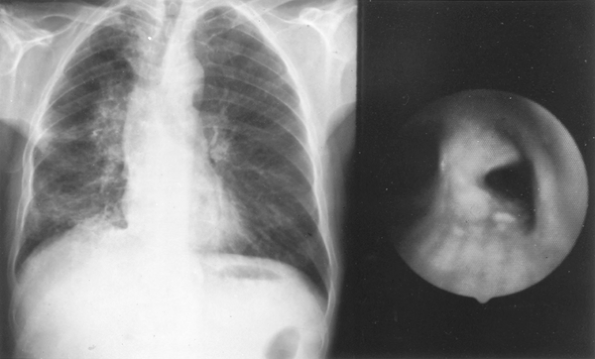 |
Fig. 108-3. Same patient as seen in Fig. 108-2. Chest radiograph and corresponding bronchoscopy 6 weeks after photodynamic therapy. The right lung is expanded, and biopsy revealed no evidence of residual cancer in the right main stem. |
McCaughan and Williams (1997) showed that patients could undergo frequent and repeated treatments. They treated a series of 175 patients, many receiving multiple treatments. At 1 month, 96% experienced either complete or partial response. In their overall series, the mean survival rate by stage of disease was stage I (not yet reached), stage II (22.5 months), stage IIIA (5.7 months), stage IIIB (55 months), and stage IV (5.0 months). They treated 16 stage I patients with photodynamic therapy as primary therapy, achieving a 93% estimated 5-year survival rate.
For medically inoperable and late-stage patients in whom life expectancy is short, the photosensitivity may interfere with reasonable quality of life. These patients must remain out of any sunlight for up to 6 weeks, a significant amount of time in a patient with limited survival. Physicians must weigh the potential side effects against any expected short-term benefits.
P.1608
Endobronchial Stents
For many years, surgeons have used silicone stents to keep open the airway in cases of benign and malignant stenosis or obstruction. These stents were of value when there were no alternatives. Because of the difficulty in anchoring the stents, their use was confined to the trachea and main-stem bronchi. T-shaped stents were used for the upper trachea and were anchored in the site of a new or previous tracheostomy. Y-shaped stents were used for the lower trachea and proximal bronchi. These required rigid bronchoscopy for placement. Short, straight stents are available and depend on a tight stenosis to keep them in position.
Silicone stents may play an important role in the management of bronchoesophageal fistulas. After the esophagus was stented, Yim and colleagues (1997) used 17 silicone stents in 15 patients to restore airway integrity. All patients noted a significant improvement in dyspnea, although they did not report on other signs or symptoms.
Through the late 1980s and early 1990s, radiologists gained experience with the use of metallic endovascular and endobiliary prostheses. Rosch and co-workers (1987) used one of the more successful stents, the Gianturco stent (Cook Europe, Denmark), for superior vena cava syndrome after radiation therapy. Davids and colleagues (1992) performed a randomized trial comparing polyethylene versus metallic stents for biliary stenosis. They found the expandable capability of the metallic stents was a distinct advantage in maintaining patency. In 1990, Varela and associates placed Gianturco stents in three patients, with endobronchial stenosis attributable to cancer in one patient. All of the patients had good results.
P.1609
Most of the current generation of stents are made by Boston Scientific (Natick, MA, U.S.A.). These covered stents come in a variety of styles, sizes, and lengths. The silicone-covered metal Wallstent pictured in Figure 108-4 can be deployed, sheathed, and redeployed off the delivery device. This new feature is helpful in the airway where placement around other lobar orifices is critical. The Ultraflex stent pictured in the airway in Figure 108-5 is a polyurethane-covered woven nitinol device that is deployed with the release of a string. This stent is safe for use with magnetic resonance imaging. It can be moved in the airway either proximally or distally for at least 1 to 2 days. The Polyflex stent is a silicone-covered polyester stent indicated for inoperable benign obstructions of the central airways, tracheoesophageal fistulae, and malignant stenoses due to compression or stricture caused by tumors. Obstructions may be lasered or dilated with a balloon dilation system (depicted in Fig. 108-6) prior to insertion. These stents are now developing a history of good long-term results.
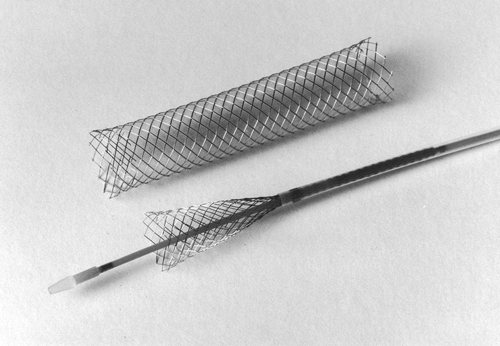 |
Fig. 108-4. One of the most popular stents in use is the Wallstent (Boston Scientific, Natick, MA). The stent is covered with silicone and can be reconstrained for repositioning during deployment. |
 |
Fig. 108-5. Ultraflex stent (Boston Scientific, Natick, MA) deployed in the airway. Note that the uncovered portion of the stent shows the woven design of the nitinol wire. |
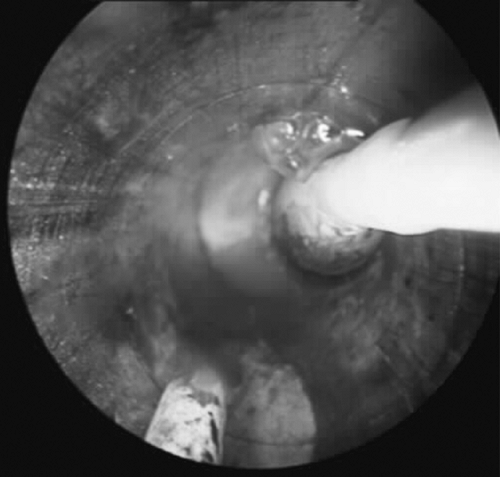 |
Fig. 108-6. Bronchoscopic picture of balloon dilation of the mid trachea. |
Another variety of stent is the Rusch dynamic tracheobronchial stent (Rusch, Kernan, Germany). Pictured in Figure 108-7, this stent is silicone reinforced with metal struts to mimic the trachea. It is considered dynamic because it can collapse posteriorly like the membranous trachea. Because of the dynamic nature of the stent, it does not have much of a problem with inspissated secretions. It is meant for use in long airway involvement, carinal involvement, or tracheomalacia.
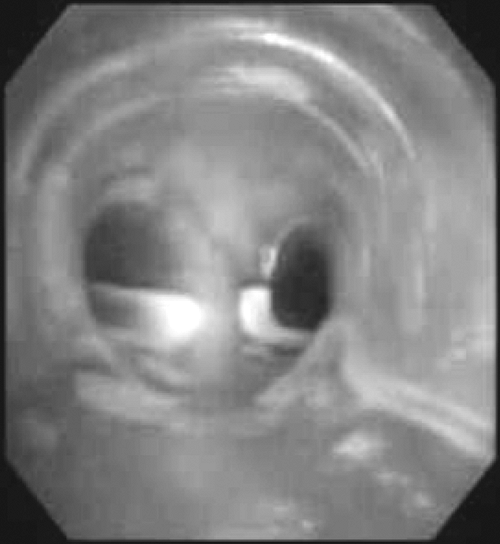 |
Fig. 108-7. Rusch dynamic tracheobronchial stent (Rusch, Kernan, Germany) deployed in the airway of a patient with a tracheoesophageal fistula. Note the metal ribs mimicking the trachea. |
Madden and colleagues (2002) reported a series of 25 patients who had either en stage malignancy including tracheoesophageal fistulas or medically inoperable airway obstruction. Twenty-eight Ultraflex stents were placed with good results. One patient had a postplacement respiratory infection; the others did well. The late problems included sputum retention, halitosis, and granulation. Orons and associates (2000) reported on the use of balloon dilation and stenting for patients with bronchial strictures following lung transplantation: 18 were for bronchomalacia and 17 were for fibrosis. Six-month patency for bronchomalacia was 71%. One-year patency for fibrosis was 100%.
Endobronchial stents have found usefulness for the vexing problem of extrinsic compression secondary to malignant disease. Dilation of the stenosis lasts only a short time, leaving
P.1610
no permanent solution. Lasering of an extrinsic compression can produce an open airway but replaces the malignant obstruction with a cicatrix that requires repeated lasering approximately every 3 weeks, adding expense and risk to the patient. Nomori and associates (1993) presented successful stent placements in a series of patients in whom over 70% of the stenoses were caused by extrinsic compression.
Another situation in which endobronchial stents have been useful is as a temporary solution for a patient presenting with a malignant obstruction. A stent can be used to open an obstruction acutely to allow expansion of atelectatic lung and drainage of postobstructive pneumonia prior to the start of radiation therapy, chemotherapy, or both. Witt and associates (1997) reported a series of 22 patients who presented with acute blockage. After the start of definitive therapy, 50% of the stents could be removed.
Special Endoluminal Stents
Malignant disease can cause obstruction of other intrathoracic structures that could be handled with an endoluminal stent. The most notable situation is superior vena caval obstruction. Gross and colleagues (1997) successfully dilated and stented 13 patients with malignant superior vena cava syndrome. One patient died of a cardiac arrhythmia 1 day after placement, but the rest of the patients had no recurrence of the syndrome.
A more difficult problem that is amenable to stent management is the malignant esophagorespiratory fistula. This devastating situation has foiled many attempts at surgical resolution. The innovative development of silicone-covered esophageal stents can allow closure of the fistula from the esophageal side. Nelson and colleagues (1997) placed 23 stents in 21 patients, with sealing of the fistula in 87% and improvement in more than one-half of the cases. Sometimes the placement of an endoesophageal stent adds to the respiratory compromise in a patient because of airway compression. In such cases, placement of an airway stent can be beneficial. I have had experience with three such patients. In each case the relief was immediate and the airway stent provided considerable palliation for a desperate situation. Takamori and associates (1996) placed stents in 12 patients with acute respiratory compromise from esophageal cancer, achieving immediate relief in 8 patients without complications.
COMPLICATIONS
Sufficient data are available for most endobronchial methods to compare complications. The incidence of complications overall is approximately 10%; approximately one-half are life-threatening. Table 108-5 lists the major complications.
Table 108-5. Complications of Endoluminal Tumor Management | ||||||||||||||||||||||||||||||||||||||||||||||||||||||||||||||||||||||
|---|---|---|---|---|---|---|---|---|---|---|---|---|---|---|---|---|---|---|---|---|---|---|---|---|---|---|---|---|---|---|---|---|---|---|---|---|---|---|---|---|---|---|---|---|---|---|---|---|---|---|---|---|---|---|---|---|---|---|---|---|---|---|---|---|---|---|---|---|---|---|
| ||||||||||||||||||||||||||||||||||||||||||||||||||||||||||||||||||||||
The methods associated with the most acute complications are cautery and the Nd:YAG laser. Endobronchial fires can be fatal, particularly because of the carbonaceous
P.1611
smoke plume from the standard endotracheal tubes (Fig. 108-8). Several companies now make special tubes that retard the initiation of a fire. The best way to prevent a fire is to keep the power below 40 watts and to limit exposure time to 3 seconds or less.
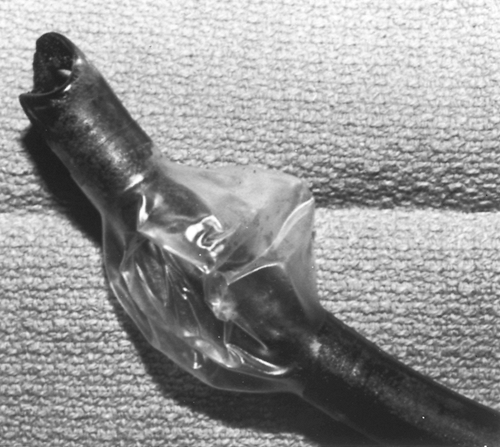 |
Fig. 108-8. Tip of an endotracheal tube after a laser fire. Note that only the tip is damaged, but the entire tube is filled with deposits from the carbonaceous plume. |
Hemorrhage is also a potentially fatal complication. Cautery and the laser most often cause bleeding acutely as a result of perforation through the bronchial wall. For the Nd:YAG laser, the risk is ever present because of the depth of penetration of the laser injury. The beam should be kept as coaxial as possible with the lumen to decrease the occurrence of this complication. Hujala and associates (2003) noted a 7% intraoperative hemorrhage rate. Delayed hemorrhage may occur with any form of therapy, but it happens most often when the pulmonary artery is involved by the tumor. When the tumor becomes necrotic and sloughs at approximately 14 to 21 days, hemorrhage ensues. Most of these patients are out of the hospital and exsanguinate before medical assistance is available.
Few complications have been reported with expandable stents. Wood (2001) reviewed complications in detail. The most common problem is inspissated secretions in the stent causing obstruction. Stents can be replaced, but because they are designed to become incorporated into the mucosa, they cause hemorrhage when removed and can lead to bronchostenosis if not replaced within a short period of time. Most bronchoscopists have limited their use to malignant obstructions or benign conditions that are considered short term or for which a stent is a temporizing maneuver until a more definitive solution can be employed.
Of special note is the unique complication of photosensitivity with photodynamic therapy. The chemical used for photodynamic therapy is a derivative of the hemoglobin molecule. The exogenous porphyrin produces the same photosensitivity found in patients with porphyria. Although most of the drug is cleared from the body within 1 week, the photosensitivity may persist for 4 to 6 weeks. Patients must remain out of even minimal sunlight. Even after this time, patients should wear a sunscreen. Any patient who may be a candidate for this type of therapy should carefully consider this limitation.
REFERENCES
Carpenter RJ 3rd, Neel HB 3rd, Sanderson DR: Cryosurgery of bronchopulmonary structures. An approach to lesions inaccessible to the rigid bronchoscope. Chest 72:279, 1977.
Carruth JA: Photodynamic therapy: state of the art. Lasers Surg Med 6:404, 1986.
Cavaliere S, et al: Endoscopic treatment of malignant airway obstructions in 2008 patients. Chest 110:1536, 1996.
Celebioglu B, et al: High dose rate endobronchial brachytherapy effectively palliates symptoms due to inoperable lung cancer. Jpn J Clin Oncol 32:443, 2002.
Davids PH, et al: Randomised trial of self-expanding metal stents versus polyethylene stents for distal malignant biliary obstruction. Lancet 340: 1488, 1992.
Doiron DR, Keller GS: Porphyrin photodynamic therapy: principles and clinical applications. Curr Probl Dermatol 15:85, 1986.
Dumon JF, et al: Principles for safety in application in neodymium:YAG laser in bronchoscopy. Chest 86:163, 1984.
Edell S, Cortese DA, McDougall JC: Ancillary therapies in the management of lung cancer: photodynamic therapy, laser therapy and endobronchial prosthetic devices. Mayo Clin Proc 68:685, 1993.
Gerasin VA, Shafirovsky BB: Endobronchial electrosurgery. Chest 93:270, 1988.
Gross CM, et al: Stent implantation in patients with superior vena cava syndrome. AJR Am J Roentgenol 169:429, 1997.
Henschke UK: Interstitial implantation in the treatment of primary bronchogenic carcinoma. AJR Am J Roentgenol 79:981, 1958.
Hernandez P, et al: High dose rate brachytherapy for the local control of endobronchial carcinoma following external irradiation. Thorax 51:354, 1996.
Hilaris BS, Martini N: Interstitial brachytherapy in cancer of the lung: a 20 year experience. Int J Radiat Oncol Biol Phys 5:1951, 1979.
Hilaris BS, et al: A new endobronchial implanter. Clin Bull 9:21, 1979.
Homasson JP, et al: Bronchoscopic cryotherapy for airway strictures caused by tumors. Chest 90:159, 1986.
Hooper RG, Jackson FN: Endobronchial electrocautery. Chest 87:712, 1985.
Hujala K, Sipila J, Grenman R: Endotracheal and bronchial laser surgery in the treatment of malign and benign lower airway obstructions. Eur Arch Otorhinolaryngol 260:219, 2003.
Jackson CL: Diseases of the Nose, Throat and Ear. 2nd Ed. Philadelphia: WB Saunders, 1959.
Jackson CL, Kozelman FW: Bronchial carcinoma. J Thorac Surg 4:165, 1943.
Lewis JW Jr, et al: Role of brachytherapy in the management of pulmonary and mediastinal malignancies. Ann Thorac Surg 49:728, 1990.
LoCicero J 3rd, Metzdorff M, Almgren C: Photodynamic therapy in the palliation of late stage obstructing non small cell lung cancer. Chest 98:97, 1990.
Madden BP, Datta S, Charokopos N: Experience with Ultraflex expandable metallic stents in the management of endobronchial pathology. Ann Thorac Surg 73:938, 2002.
Mathur PN, et al: Fiberoptic bronchoscopic cryotherapy in the management of tracheobronchial obstruction. Chest 110:718, 1996.
McCaughan JS Jr, Williams TE: Photodynamic therapy for endobronchial malignant disease: a prospective fourteen-year study. J Thorac Cardiovasc Surg 114:940, 1997.
P.1612
McElvein RB, Zorn GL: The use of lasers for tracheal bronchial lesions. In Kittle CF (ed): Controversies in Thoracic Surgery. Philadelphia: WB Saunders, 1986.
Miller JI Jr, Phillips TW: Neodymium:YAG laser and brachytherapy in the management of inoperable bronchogenic carcinoma. Ann Thorac Surg 50:190, 1990.
Mittal BB, Matuschak G, Culpepper J: Endobronchial interstitial brachytherapy using bronchofiberscope with a flexible injector system. Radiology 152:219, 1984.
Morris CD et al: Palliative management of malignant airway obstruction. Ann Thorac Surg 74:1928, 2002.
Nelson DB et al: Silicone-covered Wallstent prototypes for palliation of malignant esophageal obstruction and digestive-respiratory fistulas. Gastrointest Endosc 45:31, 1997.
Nomori H, et al: Indications for an expandable metallic stent for tracheobronchial stenosis. Ann Thorac Surg 56:1324, 1993.
Orons PD, et al: Balloon dilation and endobronchial stent placement for bronchial strictures after lung transplantation. J Vasc Interv Radiol 11: 89, 2000.
Ossoff RH, et al: Limitations of bronchoscopic carbon dioxide laser surgery. Ann Otol Rhinol Laryngol 94:498, 1985.
Prevost A, et al: Endobronchial brachytherapy in combination with external beam irradiation in obstructing malignant bronchial tumors. Oncol Rep 10:921, 2003.
Rosch J, et al: Gianturco expandable wire stents in the treatment of superior vena cava syndrome recurring after maximum tolerance radiation. Cancer 60:1243, 1987.
Schray MF, et al: Management of malignant airway compromise with laser and low dose rate brachytherapy. The Mayo Clinic experience. Chest 93:264, 1988.
Shapsay SM, Simpson GT 2nd: Lasers in bronchology. Otolaryngol Clin North Am 16:819, 1983.
Spasova I, Petera J: Long-term clinical benefits of the low dose rate endobronchial irradiation of malignant airway obstructions. Neoplasma 48: 234, 2001.
Taber SW, et al: The treatment of malignant endobronchial obstruction with laser ablation. Surgery 126:730, 1999.
Takamori S, et al: Expandable metallic stents for tracheobronchial stenoses in esophageal cancer. Ann Thorac Surg 62:844, 1996.
Varela A: Use of Gianturco self-expandable stents in the tracheobronchial tree. Ann Thorac Surg 49:806, 1990.
Walsh DA, et al: Bronchoscopic cryotherapy for advanced bronchial carcinoma. Thorax 45:509, 1990.
Witt C, et al: Temporary tracheobronchial stenting in malignant stenoses. Eur J Cancer 33:204, 1997.
Wood DE: Airway stenting. Chest Surg Clin N Am 11:841, 2001.
Yim APC, Abdullah, VJ, Izzat MB: Comment on Takamori S et al: Expandable metallic stents for tracheobronchial stenoses in esophageal cancer. Ann Thorac Surg 63:1511, 1997.
EAN: 2147483647
Pages: 203